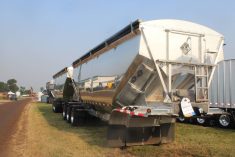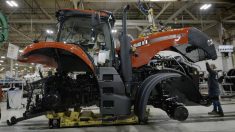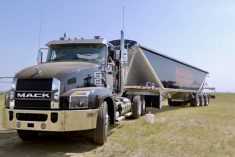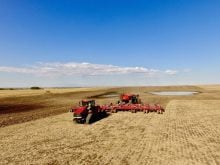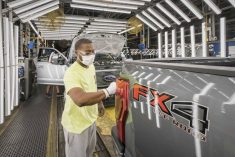Just about every producer is used to backing up towed machinery and trailers. It’s an everyday occurrence on the farm. But not everyone with a driver’s licence is capable of easily navigating a truck and trailer through the rear-view mirror. To help those directionally challenged drivers and anybody who would just like reversing a trailer to be an easier process, Ford recently introduced a feature available on 2016 F150 pickups called Pro Trailer Back Up Assist.
We at Grainews wondered if this is a feature farmers would like. When we needed a truck to pull a trailer loaded with UTVs back and forth to our UTV Challenge at the Ag in Motion show site near Saskatoon in July, Ford offered to let us try out a new F150 equipped with that feature. That allowed us to not only evaluate Pro trailer Backup Assist, but it let us see how the F150 handled all the aspects of towing. Our test truck was equipped with several options designed to make towing easier, including a rear-view camera and large side mirrors.

It also had the 7,000 pound GVWR package and a 5.0 litre engine under the hood mated to a six-speed automatic transmission. All of that was linked to a 3.55 rear axle with electronic differential lock. And since it was a King Ranch model, we were able to enjoy some additional in-cab luxury as a bonus.
The PTBA requires a little set up work before the truck can do all that complicated reversing on its own. With just the manual for guidance and a couple of tips from the fleet manager at the dealership where we picked up the truck, we set to prepping the Grainews flatdeck trailer to make use of the option.
Setting up the trailer
First, each trailer needs to be fitted with a special chequered decal that can be identified by the rear-mounted camera on the truck tailgate. Knowing where this decal is relative to the truck is how the computer decides which way to turn the wheels.

Next, once the decal is in place, a few measurements are required to locate its distance from the camera and the rear of the truck. Then, those numbers need to be entered into the truck’s computer via the dashboard controls. Doing that is just a matter of following the prompts and would certainly rank low on anyone’s degree-of-difficulty scale.
In all, set up took only about 10 minutes.

The truck can store data on several trailers, each identified by a name, so switching between trailers on the farm just requires selecting the one in use from the dash display before activating the PTBA.
Over the course of our week with the F150 we did notice a couple of problems that farm owners will no-doubt encounter if they use this feature. After logging a few miles on some gravel surfaces, the build-up of dust on the decal seemed to interfere with the truck computer’s ability to recognize and locate it on the trailer hitch. A quick wipe easily solved that problem. Although, clearing it off after travelling on wet gravel roads might mean scraping mud away.
But there was another more difficult snag to deal with. Our trailer had a permanently mounted jack close behind the ball connection. When making sharp turns while backing up, the jack often obscured the decal and the PTBA wasn’t able to continue with the manoeuvre. The decal had to be mounted within a set distance from the centre of the trailer hitch ball, but with the jack and emergency braking equipment mounted in that area, we were limited to where we could put it. That wouldn’t be a problem on some trailers with different jack positions and hitch designs. Our trailer, however, seemed to be a worst-case scenario for this feature.
In the field
In our tests, straight-back reversing was a piece of cake, and we could easily reverse for miles if we wanted, at speeds a driver wouldn’t normally feel comfortable with. The truck followed a laser-straight line, and the rear-mounted camera’s view via the dash monitor really made a nice addition to the large side mirrors to ensure we saw where we were going. Easy left or right turns were also no problem.
To make turns, trucks equipped with PTBA have a dial on the dashboard the driver uses instead of the steering wheel to get the trailer to move in the required direction.

Overall, we found it to be a pretty handy feature while we hauled the Grainews trailer around. Even drivers experienced in backing trailers will probably like this feature. It made some manoeuvres quicker and simpler. Pro Trailer Backup Assist is included in the trailer tow package option, which gets paired with Adaptive Cruise Control and adds $1,500 to the window sticker price.
Since we had the F150, we didn’t limit our observations of it to the PTBA feature. We liked the overall stability of the truck when towing, even through some extreme rainfall conditions which made the roads very slippery.
We racked up 878 kilometres before making fuel economy calculations. The F150 dragged a 16-foot flat deck behind it for most of that distance, both loaded and empty. Part of the distance was through all that extreme rainfall that put a lot of standing water on the highway and was bound to negatively affect mileage numbers. There was some city driving as well and we didn’t scrimp on AC use. Average fuel consumption through all of that was a pretty acceptable 16.5 l/100 km.
Read Also

Claas brings 1000 Series SP forage harvesters to Canada
In mid-August, Claas unveiled its new line of Jaguar forage harvesters at an event in Visalia, California, deep in the heart of that state’s dairy region.
For a video look at the set up and use of Pro Trailer Backup Assist, watch the e-QuipTV episode.




